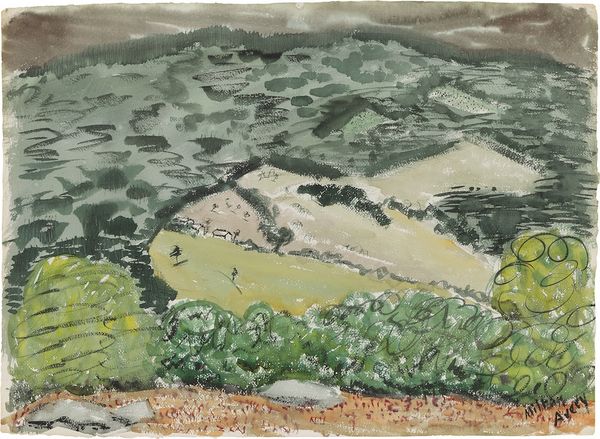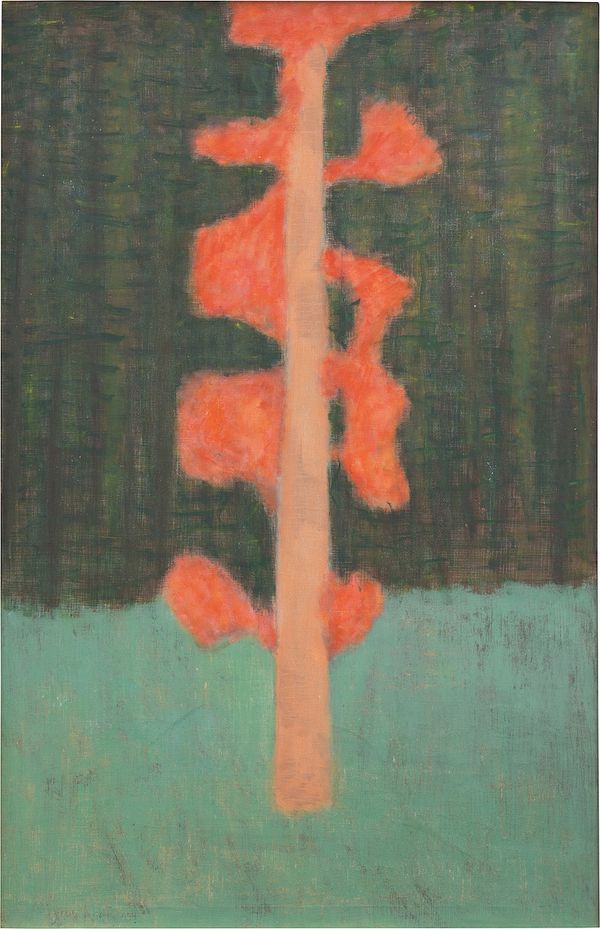Milton Avery, Hills and Fields, 1943. Milton Avery: A Sense of Place.
Written by Timothy Rub, The George D. Widener Director and Chief Executive Officer, Philadelphia Museum of Art
Some years ago, when I was Director of the Cincinnati Art Museum, I made the acquaintance of an elderly gentleman who intended to bequeath his collection to us. Although he had largely focused on early modern photography and was deeply interested in the subject, he readily admitted to me that among the many works he had acquired over the course of several decades of collecting, his favorite was a painting by Milton Avery.
Titled, in the artist’s laconic way, Foam on the Rocks and dating to 1949, the work is simplicity itself: a network of roughly painted white lines on a black field comprises most of the surface. The black shape—clearly the rock of the title—angles down from the top left corner, revealing a gray sky beyond and, just above it, the ragged edge of a wave can be seen receding back into the sea.
None of these individual figurative elements could perhaps be recognized as such without the aid of the title that Avery gave to the painting; but with it they snap into focus, delighting the viewer with the recognition of its subject and the opportunity to appreciate the subtle visual patterns and spatial relationships that are the hallmarks of Avery’s pictorial practice and animate all of his works.
Milton Avery, Hint of Autumn, 1954. Milton Avery: A Sense of Place.
The title of this lovely and succinct survey of the artist’s career might strike the reader, at first blush, as a bit shopworn and predictable. But it is entirely apt and gets right to the point in insisting that the expression—or, better still, the capturing—of a sense of place is essential to understanding what Avery was trying to achieve. This is perhaps most easily seen, and felt, in the landscapes he painted in the 1920s and 1930s, during which he summered first in Gloucester for more than a decade and later in the Green Mountains in Vermont and on the Gaspé Peninsula in Quebec.
Not surprisingly, these bear the stamp of the regionalist aesthetic that became one of the dominant strains of American painting between the two world wars. Even so they also clearly reflect Avery’s growing embrace of modernism as he continued to mature as a colorist and to simplify his pictorial compositions into arrangements of flat shapes in contrasting colors and tones.
The outcome of this process as it unfolded over the course of the 1940s and thereafter is the Avery that we know best and admire the most today. It is tempting to say that works like Hint of Autumn, painted in 1954 in New Hampshire, or Dark Pool, painted a few years earlier in Provincetown, although inspired by these specific locales, also transcended them by virtue of their abstraction, which imbues them with an iconic, almost universal character.
Milton Avery, Dark Pool, 1950. Milton Avery: A Sense of Place.
Yet nothing could be farther from the truth. Indeed, as Barbara Haskell observed in her brilliant study of Avery published nearly 40 years ago, as reductive as his work may have come to be—to the point at which it bordered on abstraction—it was always firmly rooted in things he had seen and felt, in the particulars of a specific place. For the artist this could be found not only in the panoramic view distilled into the salient elements of land, sea, and sky for which he is so widely admired, but also—and increasingly so—in the telling detail: the undulating edge of a hill, a breaking wave, a solitary tree, or a rock on the shoreline, worn down over time by the force of wind and water.
This was, in fact, what captured the attention and affection of my elderly friend, who so dearly loved the painting by Avery in his collection, Foam on the Rocks, which was most likely inspired by the time he spent at Pemaquid Point, in Bristol, Maine, during the summer of 1948. When I asked him why he was so fond of the work, he didn’t hesitate, responding, “I can, quite literally, feel the place—the sound and weight of the wave as it breaks against the rock and drains off of its surface.“
It was Avery’s great gift to make the part stand for the whole and to invest a simple detail with the capacity to tell us far more than we assume it might a first glance. And it is what continues to endear his work to us today.
Discover More from Milton Avery: A Sense of Place >
Recommended Reading
The Rothko Effect: Why Does Art Move Us? >
The Art Lover's Guide to River Towns >



